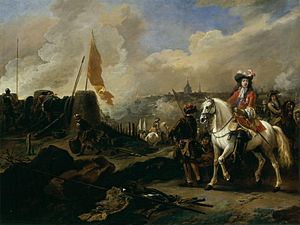John Graham, 1st Viscount Dundee facts for kids
Quick facts for kids
John Graham, Viscount Dundee
|
|
|---|---|
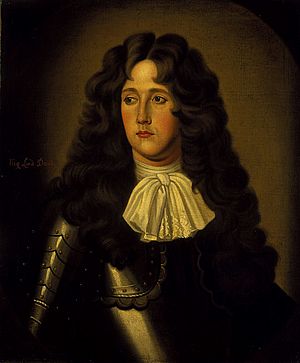
John Graham of Claverhouse, later Viscount Dundee
|
|
| Nickname(s) | Bluidy Clavers, Bonnie Dundee |
| Born | 21 July 1647 Glen Ogilvie, near Glamis, Angus, Scotland |
| Died | 27 July 1689 (aged 41) Killiecrankie, Perthshire, Scotland |
| Buried |
St Bride's Kirk, Blair Castle, Perthshire, Scotland
|
| Allegiance | |
| Service/ |
Infantry and Dragoons |
| Years of service | 1672–1689 |
| Rank | Major-General |
| Unit | Lockhart's Regiment 1672–1674 Dutch Scots Brigade 1674–1678 Independent Company 1678–1689 |
| Commands held | Jacobite Commander in Chief for Scotland, 1689 |
| Battles/wars | Franco-Dutch War 1672-1678 Battle of Cassel Battle of Saint-Denis Battle of Drumclog Battle of Bothwell Brig Argyll's Rising Jacobite rising of 1689 Battle of Killiecrankie |
John Graham, 1st Viscount Dundee (born 1648 – died 1689) was a Scottish soldier and nobleman. He was known for being loyal to the King and the Episcopal Church in Scotland.
He was in charge of keeping order in southwest Scotland during a time of religious trouble in the late 1600s. Later, he led a group called the Jacobites who supported King James VII.
After he died, some historians called him "Bluidy Clavers" (Bloody Clavers). This was because of his role in stopping a religious group called the Covenanters. However, his own letters often suggested being kind to Covenanters. He even married into a Covenanter family.
Later, as a general, he stayed loyal to King James VII of Scotland after the Revolution of 1688. He gathered Highland clans who supported the King. He led them to victory at the Battle of Killiecrankie, but he died in the battle. This first Jacobite uprising didn't succeed, but John Graham became a hero. He earned another nickname, "Bonnie Dundee".
Contents
Early Life of John Graham
John Graham's family was related to King Robert III. John was the older son of Sir William Graham and Lady Madeline Carnegie. His family owned the Claverhouse estate near Dundee.
He was likely born in 1648. He had two sisters and studied at the University of St Andrews with his younger brother, David. He finished his studies in 1661.
After his father died around 1652, John and David were cared for by their uncles. In 1669, John Graham inherited the Claverhouse estate. This included Claypotts Castle and a house in Glen Ogilvie.
Serving in the Franco–Dutch War
In the 1600s, many people in Scotland and England didn't like having large armies. This meant that Scots who wanted to be soldiers often joined armies in other countries. John Graham was one of these soldiers.
He joined the French army in 1672 when the Franco-Dutch War began. He was a Captain in a Scottish regiment that fought with the French. England was allied with France at this time.
However, supporting Catholic France against the Protestant Dutch Republic was not popular. England left the war in 1674. Many English and Scottish soldiers then joined the Dutch army, including Claverhouse.
He fought in the Battle of Seneffe in 1674. Some stories say he saved the young William of Orange there, but this is not certain. In 1678, Claverhouse left the Dutch army and returned to Scotland.
Military Service in Scotland
In 1678, John Graham was given command of a company to police southwest Scotland. His main job was to stop illegal outdoor meetings of Presbyterian groups called Conventicles.
These Covenanters were a religious group who disagreed with the King's church. The situation became very tense when Covenanter militants killed Archbishop James Sharp in May 1679.
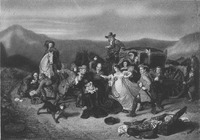
On June 1, 1679, Claverhouse found a large Covenanter meeting. They were ready for battle. He later wrote that they were "drawn up in batell, upon a most advantagious ground."
The Covenanter force was led by 19-year-old William Cleland. They were on a hill with a marsh in front. Claverhouse's soldiers, called dragoons, tried to advance but got stuck in the wet ground. The Covenanters then charged.
Claverhouse's horse was hurt and ran away from the battle. His soldiers followed. This fight, called the Battle of Drumclog, was a small skirmish. But it was a defeat for the government and boosted Covenanter spirits.

Claverhouse went back to Glasgow. The Covenanters tried to attack Glasgow but couldn't without cannons. Claverhouse then went to Stirling Castle to wait for more soldiers.
He was not blamed for the defeat at Drumclog. On June 22, the two sides met again at the Battle of Bothwell Brig. This time, the Covenanters were completely defeated.
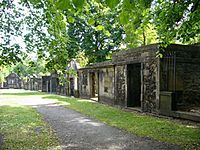
About 1200 Covenanter prisoners were held in Greyfriars Kirkyard in Edinburgh. Claverhouse went to London to complain that the Duke of Monmouth was too kind to them. This started his close friendship with King James.
In 1680, King James gave him the land of Freuch in Galloway. In 1682, he became a colonel of a new regiment in Scotland. He also gained control of Dudhope Castle and the title of Constable of Dundee in 1684. In 1683, he joined the Privy Council of Scotland.
Marriage and Promotions

In 1684, John Graham married Lady Jean Cochrane. Her grandfather was a strong Covenanter.
After King Charles II died in 1685, Claverhouse was briefly removed from the Privy Council. This happened because he stood up for ordinary soldiers who were being treated badly. But he was put back in May.
In 1686, he was promoted to major-general. He also became the Lord Provost of Dundee. As Provost, he stopped the death penalty for theft in his area. In 1688, King James VII made him Viscount Dundee. He was also given command of all the King's forces in Scotland.
Service After the Revolution of 1688
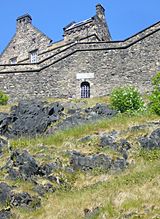
Dundee returned to Scotland when a new meeting of leaders was planned in Edinburgh. He tried to convince the Duke of Gordon to hold Edinburgh Castle for King James.
The meeting of leaders was against King James. Dundee thought about forming a rival meeting in Stirling to support King James. But his friends were unsure, so the plan was dropped.
On March 18, 1689, he left Edinburgh with fifty loyal soldiers. Soon, news reached the leaders that he had climbed the castle rock to talk with Gordon.
Dundee went to Dudhope. On March 30, he was publicly called a traitor. He had offered to promise he wasn't fighting, but it didn't help. In April, people tried to arrest him at Dudhope and Glen Ogilvy. But he moved quickly and secretly, escaping to the north.
In 1689, after King James VII was overthrown, Dundee continued to support the Stuart kings. He was the commander-in-chief of all Scottish forces. On April 13, Dundee raised the Scottish Royal Standard on Dundee Law. This showed his support for King James and the Jacobite cause.
However, the people of Dundee were not very welcoming. The city was guarded by soldiers who supported the new King William. This might explain why the gates were closed to him. For four months, he gathered support. He was good at writing letters and using small attacks to gain time.
His biggest victory was at the Battle of Killiecrankie later that year. He fought against a much larger army led by General Hugh Mackay. Dundee led the Jacobite charge down the hill at sunset.
The Highlanders won the battle completely. But Dundee was shot under his armor by a musket ball and fell from his horse. He died on the battlefield.
Stories say Dundee asked a soldier, "How goes the day?" The soldier replied, "Well for King James, but I am sorry for your lordship." Dundee then said, "If it goes well for him, it matters the less for me."
Dundee's death ended the uprising, even though it was a victory. Many legends grew around his death. The most famous false story was that he couldn't be hurt by lead bullets. It said he was killed by a silver button from his own coat.
He was carried a few miles to St Bride's church, near Blair Castle. He was buried there. The stone marking his grave incorrectly says he was 46, but he was actually 41. His helmet and breastplate are kept in Blair Castle.
The song "Bonnie Dundee" was around before John Graham became Viscount Dundee. Many old songs with that title were about the city of Dundee. But after Walter Scott wrote his poem in 1828, the name "Bonnie Dundee" became linked to John Graham.
In Literature
- The Grameid, an epic poem in Latin, tells the story of Claverhouse's campaign in 1689. It was written by James Philip, a relative of Dundee.
- Sir Walter Scott wrote a poem called Bonnie Dundee in 1830 about Claverhouse's campaign. It was later made into a song.
- Claverhouse is a main character in Sir Walter Scott's novel, Old Mortality (1816). He also appears in Redgauntlet and The Brownie of Bodsbeck by James Hogg.
- Rosemary Sutcliff wrote a young adult novel about him called "Bonnie Dundee" (1983). It tells the story of a young follower of Dundee.
- "The Phoenix and the Laurel" (1954) by Jane Lane (author) is another historical novel about Claverhouse.
- In a Father Brown short story by G.K. Chesterton, a character says Dundee sold his soul to the Devil. Father Brown disagrees, saying Dundee was "simply a seventeenth-century professional soldier."
- Robert Burns mentions Claverhouse in his song "The Braes O'Killiecrankie."
- Ian Maclaren wrote a historical novel called Graham of Claverhouse in 1907.
- In 1984, Dutch author A. Alberts wrote 'De Zilveren Kogel' (The Silver Bullet) with Claverhouse as the main character.


